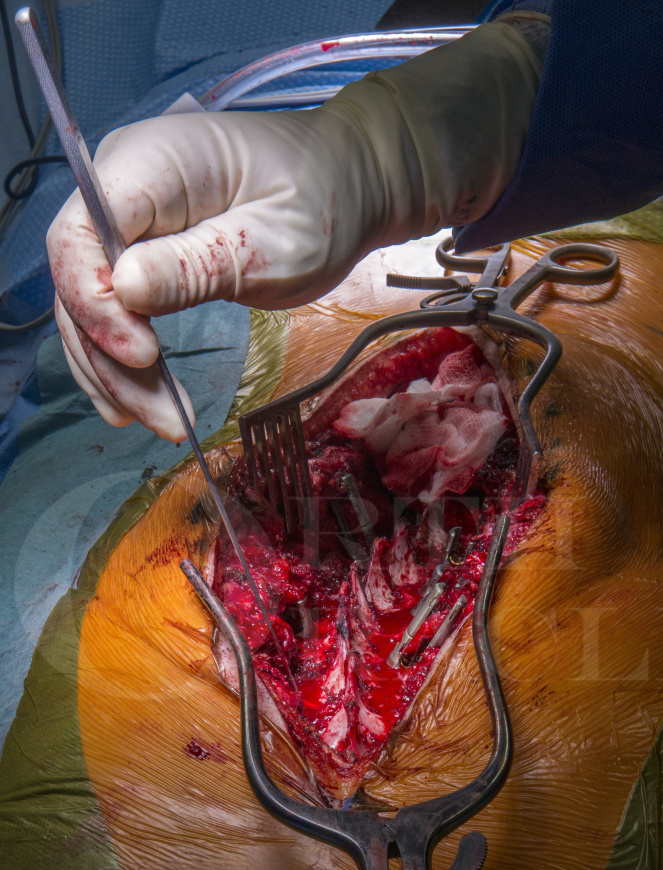Posterior Instrumented Adolescent Idiopathic Scoliosis Correction and Fusion (T4 to L4) using Globus CREO system
Overview

Subscribe to get full access to this operation and the extensive Spine Surgery Atlas.
Learn the Posterior Instrumented Adolescent Idiopathic Scoliosis Correction and Fusion (T4 to L4) using Globus CREO system surgical technique with step by step instructions on OrthOracle. Our e-learning platform contains high resolution images and a certified CME of the Posterior Instrumented Adolescent Idiopathic Scoliosis Correction and Fusion (T4 to L4) using Globus CREO system surgical procedure.
A scoliosis, by definition, is a lateral curvature of the spine of coronal Cobb angle of greater than 10 degrees. The most common form is Adolescent Idiopathic Scoliosis (AIS). Children and adolescents between the ages of 10 and 18 can suffer from scoliosis caused by congenital, syndromic, traumatic, pathological or neurologic conditions. If the aetiology is not found, it is classified as idiopathic scoliosis.
The term “idiopathic”, to some extent, is a mis-nomer as it suggests the aetiology is unknown whereas in truth, it is simply not yet fully understood. Although AIS does not seem to be associated with any particular condition and is generally seen in otherwise healthy adolescents, research to date shows it to be a complex condition in which genetic, mechanical and hormonal factors are implicated in the pathogenesis.
AIS affects 0.5-3% of the population. Presentation is usually between ages 10 to 18 years of age. Female to male ratio 1:1 for small curves; 10:1 for curves greater than 30 degrees. It encompasses a range of severity and is relatively common. In its milder forms, scoliosis may produce isolated trunk asymmetry. Very large curves, greater than 100 degrees, may cause severe disfigurement and, occasionally cardiopulmonary compromise.
The above definition of a scoliosis does however over simplify the spinal deformities associated with the clinical presentation, since the definition (and what patients and parents often get hung-up on) relates to a greater than 10 degree coronal cobb angle. This definition describes the spinal curve only in 2-Dimensions (10 degree lateral curvature). A scoliosis is however a 3-Dimension deformity. In addition to the coronal spine curvature there is segmental vertebral rotation, which creates a “spiral shape” rather than the “S-shape” a PA radiograph depicts. This vertebral rotation in the thoracic spine clinically results in a thoracic rib hump and in the lumbar/thoracolumbar spine a loin hump and waist asymmetry. Patients will usually present after these changes in the shape of their back are noticed, either by themselves or a family member/friend.
A Posterior Anterior (PA) radiograph will confirm the diagnosis. A right thoracic curve is most common. Left sided curves are seen but are not “typical” for AIS. Lenke produced a comprehensive classification based on Posterior-Anterior, lateral and bending radiographs.
Not all AIS curves need treatment. Some curves can be judged low risk of progression and/or causing later problems. In such clinical presentations, observation is needed until skeletal maturity. Some curves may be managed with bracing, with the aim to prevent curve progression to a magnitude that may cause later problems (45-50 degrees) often require surgery.
The goal of surgical treatment in AIS is to achieve and maintain a long term improvement in coronal deformity, sagittal balance and axial derotation while minimising the number of vertebral segments fused.
Operative management of scoliosis has progressed significantly over the past three decades. Posterior approaches have become the gold standard for treating AIS since Harrington’s first report in the 1960s. Recently more powerful and versatile pedicle screw constructs have allowed for improved correction of deformity and resulted in fewer patients requiring anterior release surgery.
There are several instrumentation systems, specifically designed for spinal deformity correction surgery, available. Each as it’s own advantages and disadvantages. In this technique I have used Globus CREO. Its advantages include a good selection of pedicle screw sizes, the ability to use either a 5.5mm or 6mm rods and that the reduction towers connect easily to the screw system. The towers can be easily added for de-rotation manoeuvres as required during the correction. Additionally the poly-axial screws and uniplanar screws can be converted to mono-axial screws intra-operatively. The instrumentation system is also competitively priced which is an important factor in todays health care economics.
Other techniques for scoliosis correction that may be of interest to the reader can be found on OrthOracle at https://www.orthoracle.com/library/anterior-release-of-scoliosis-access-by-thoracotomy/
Clinicians should seek clarification on whether any implant demonstrated is licensed for use in their own country.
In the USA contact: fda.gov
In the UK contact: gov.uk
In the EU contact: ema.europa.eu
Online learning is only available to subscribers.



















